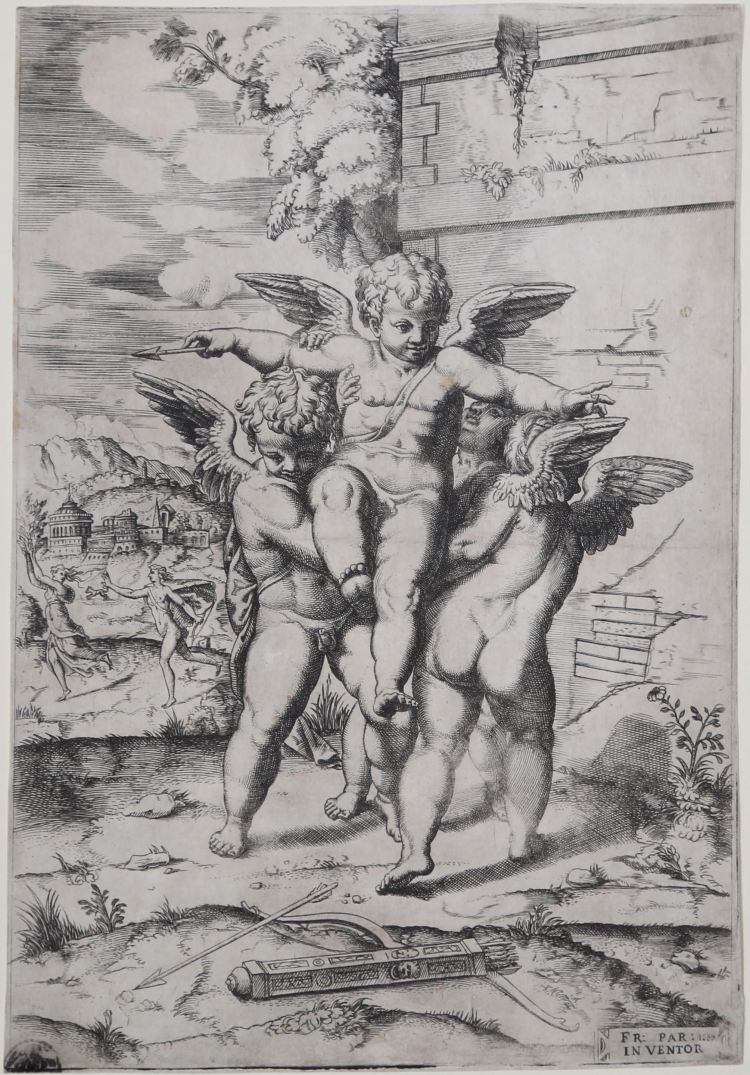




| Reference: | S35377 |
| Author | Enea VICO |
| Year: | 1560 ca. |
| Measures: | 218 x 316 mm |



| Reference: | S35377 |
| Author | Enea VICO |
| Year: | 1560 ca. |
| Measures: | 218 x 316 mm |
Cupid, holding an arrow in his right hand, held up by three winged putti; a quiver on the ground in front of them; in the background left Apollo pursuing Daphne, turning into a tree; town and landscape in far background.
Etching with engraving, 1530 circa, inscribed on a tablet lower right: 'FR. PAR./INVENTOR'. After a lost drawing by Parmigianino.
Magnificent proof, printed on contemporary laid paper with watermark “triple mount in shield with a dove”, trimmed close to platemark, overfold on the left side, in the tablet lower right original ink addition with the date “1530”, unidentified collection mark on the hand-left corner, generally in good condition.
The composition is based on a lost drawing by Parmigianino. There is a copy of the original drawing in the British Museum, see Popham 1971, no. OC 2.
The print, not in Bartsch, is attributed to Enea Vico by Phyllis Deaborn Massar, for the obvious stylistic analogies: “This note is in the form of a query. While inventorying the 275 prints in the Metropolitan Museum of Art's Mariette Album of prints by or after Parmigianino (inv. no. 27.78.2) I found three prints, so far unattributed, which I thought might be by Enea Vico (1520-70). I present my arguments here with the hope that some more expert eye than mine may be able to support my attributions or suggest more plausible ones. Four Putti in a Landscape (27.78.2.178), 314 x 215 mm, etching and engraving, not in Bartsch (fig. 158). At the lower right within the plate is a tablet with the inscription FR:PAR:/ INVENTOR (and, in pen, Mariette 1697). A number of prints by Vico contain similar inscriptions, which are variations on the credit to Parmigianino (Bartsch 17, 30, p. 27.289.17; Bartsch 27, TIB, 30, p. 38.294.27; Bartsch 39, TIB, 30, p. 55.301.39). These and other prints by Vico are in the Mariette Album, Leaves 65-69 and 71. Immediately preceding these, on Leaf 64, is this print, Mariette seemingly making a connection. Stylistically, there seems to me no doubt that this print is by Vico. Note the horizontal parallel shading, interrupted by fluffy clouds; the shading of limbs; the carefully delineated locks of hair and the feet; cross- hatched shadows of figures; the undulating foregrounds with weedy Plants. A drawing of the putti, described as an old copy of a Parmigianino drawing, is in the British Museum (1870- 8-13-904; Popham I, p. 233, 2; III, pl. 267). Popham cites this print but with no suggestion as to printmaker”.
Bibliografia
Nagler, Monogr. VIII.515.16; Popham, Catalogue of the Drawings by Parmigianino, 1971, p. 233, OC 2; P. Dearborn Massar, Three prints by Enea Vico?, in “Print Quarterly”, 2007,3, p. 282, fig. 158 (attributed to Enea Vico).
Enea VICO (Parma 1523 - Ferrara 1567)
|
Enea, son of Francesco, was antique dealer, drawer, engraver and numismatist. He was born in Parma on January 29th, 1523, according to what Huber says. After the first school years in the city, and very likely after he made acquaintance with the works of Giulio Romano, Vico moved to Rome in 1541. He then worked for Tommaso Barlacchi, who also engraved with him a series of Grottesche, in 1542. In the classical atmosphere of Rome, Vico’s style developed according to that of Perin del Vaga and Francesco Salviati, but always with Parmigianino as main reference. Around the first half of the century and after studying the works of Marcantonio, Agostino Veneziano, Caraglio and Bonasone, Vico acquired his own, peculiar style which can be seen in his main works. From Rome Vico moved to Florence, where he worked for Cosimo I, and then went to Venice, in 1557. In 1563 he is already in Ferrara, working for Alfonso d’Este till his death in 1567.
|
Enea VICO (Parma 1523 - Ferrara 1567)
|
Enea, son of Francesco, was antique dealer, drawer, engraver and numismatist. He was born in Parma on January 29th, 1523, according to what Huber says. After the first school years in the city, and very likely after he made acquaintance with the works of Giulio Romano, Vico moved to Rome in 1541. He then worked for Tommaso Barlacchi, who also engraved with him a series of Grottesche, in 1542. In the classical atmosphere of Rome, Vico’s style developed according to that of Perin del Vaga and Francesco Salviati, but always with Parmigianino as main reference. Around the first half of the century and after studying the works of Marcantonio, Agostino Veneziano, Caraglio and Bonasone, Vico acquired his own, peculiar style which can be seen in his main works. From Rome Vico moved to Florence, where he worked for Cosimo I, and then went to Venice, in 1557. In 1563 he is already in Ferrara, working for Alfonso d’Este till his death in 1567.
|